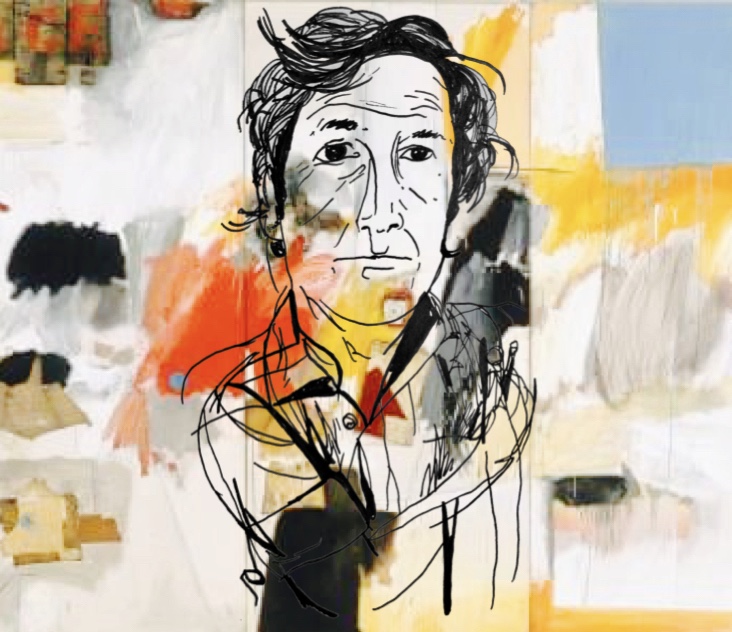You see a bunch of squares on a canvas. Some are plain, some have stripes on them, some are painted over. There are different marks on the surface- a blotch of red in the corner, a swift stroke of blue across the center. Your eyebrows begin to furrow. You scour the canvas for a familiar image and breathe a little when you see a photograph of JFK mixed into this collage- finally, something you recognize. But what does that mean? You continue to stare forward in confusion as the self-proclaimed art student besides you goes into a dissertation on the artistic evolution of Robert Rauschenberg in the postwar decades. You nod along knowingly as your internal confusion deepens. Maybe coming to the MoMA was a mistake.
Well, I can assure you that your trip to the MoMA was certainly not a mistake. Although the works of Robert Rauschenberg may be confusing to any first timer, they possess a certain allure that continues to draw crowds from around the world to contemporary art museums. Rauschenberg’s pieces chronicle much of modern American history, taking the country from a period of post-war conformity in the 1950s to a new era of globalization in the 2000s. But if we want to understand Rauschenberg’s true impact on the course of this nation’s history, we should start at the beginning.
Born in Texas, Rauschenberg spent much of his early school days as a chronic doodler and a slow reader. He had dyslexia, which made it difficult to focus in class but opened up a creative outlet through art. He went on to study pharmacy at the University of Texas, but was soon drafted into the Navy. It was here at his base in California that Rauschenberg revisited his interest in art. The Henry E. Huntington Library and other art museums in San Diego exposed the young artist to art forms that incorporated two- and three-dimensional materials, known as “combines.” Rauschenberg drew inspiration from these works to launch his own artistic career.
Using the techniques he observed in San Diego, Rauschenberg transitioned the American art world from abstract expressionism to modernism. The artist is considered one of the key figures in the Neo-Dada movement, a radical shift in the 1950s that utilized mass media and found objects and emphasized execution over the mundane subject matter. This new movement rebelled against the dramatic tone of the reigning abstract expressionist style and was seen as a thorn in the side of a society that was hyper-focused on conformity. However, the movement eventually grew in influence and would pave the way for offshoots such as pop art, minimalism, and conceptualism.
In the early 1960s, Robert Rauschenberg began producing his own “combines,” merging kitsch and fine art. His works incorporated photographs, wallpaper, other printed materials, and paint. Rauschenberg placed a heavy emphasis on the use of words in his artwork. Palindromes, or sentences spelled the same forwards and backwards, are present in many of his works. One of these is the 1985 piece Able was I ere I saw Elba, which depicted Napoleon’s exile to the isle of Elba. About using words in his art, Rauschenberg wrote, “I got hooked. Also because I am dyslexic, I was very good at the print workshop economically, because I can see backwards and forwards at the same time! I don’t have to proof it, I can already see it!”
As the years went by, Rauschenberg ascended in importance not only in the United States but across the world. In 1984 at the United Nations, the artist announced the Rauschenberg Overseas Culture Interchange, a seven-year tour to promote “world peace and understanding” across ten nations: Mexico, Chile, Venezuela, Beijing, Tibet, Japan, Cuba, the Soviet Union, Berlin, and Malaysia. He drew inspiration from each country he visited and left behind a piece of art. Through this project, Rauschenberg promoted the globalization and artistic connections across countries, leaving behind a rich legacy beyond the United States.
Although it’s easy to feel overwhelmed when you first see the seemingly disconnected materials of Rauschenberg’s liking thrust together onto a single canvas, lean in a little closer and you’ll see that all of these different objects are part of the same narrative. This narrative is one that ushered the art scene into a new era of modernism and the world into a new era of globalization. So the next time you’re at the MoMA, take a moment to appreciate Robert Rauschenberg’s immense contributions to our society. And feel free to completely one-up that pretentious art student standing beside you.
Swathi Kella
editor in chief
Graphic: Evie Cullen

